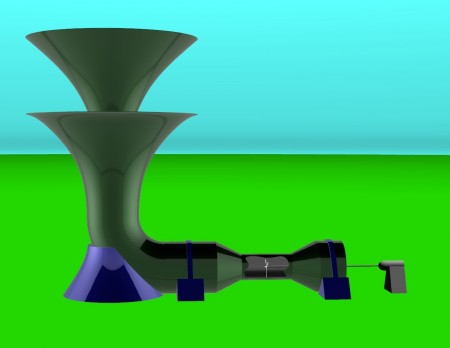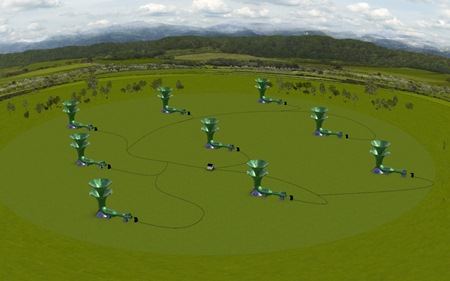SheerWind is a Chaska, Minn.-based startup with a wind power generator concept that looks nothing like any wind turbine you have ever seen. The venture’s “Invelox” technology recently won the 2011 CleanTech Open’s Sustainability Award for the North Central Region. SheerWind’s founder and CEO, Daryoush Allaei, has 25 years of research and development experience, including leading projects funded by the U.S. departments of Defense and Energy.
Interestingly, his technical expertise is not in wind power, or even renewable energy, but in systems dynamics–specifically, noise and vibration. He first developed the idea for Invelox in late 2008, while working on a proposal for a project to monitor wind turbine vibration, in response to a Department of Energy solicitation.
“DOE wanted a technology that could monitor the vibration of the [wind turbine] blades, to help them manage wind energy more cost-effectively,” Allaei said to us in a recent interview. “When I was reviewing what they were asking for, I just thought, ‘Wow! They are trying to solve the wrong problem.’ They were asking me to go 60 to 100 feet up in the air, when what I really needed to do was bring [the cost of wind energy] down for them. I thought something had to change. So I closed my door and I sat down and thought about what else we could do that makes more sense. That’s how I came up with this idea of harvesting wind on the ground.”

The result is what to looks to be a pretty novel approach to generating wind power. Allaei’s “Invelox” technology (named for increasing velocity) looks more like a giant phonograph player than a wind turbine. Essentially, it works by capturing wind, funneling it into a tunnel to increase velocity, and channeling it into a ground-based turbine.
Allaei typically describes the system by comparing it to a hydroelectric dam:
“If you look at a hydro dam, the basic principle is to collect water and then, down below there are small openings where the water is allowed to escape. By simple physics, when you do that, the water speeds up. It is in that small opening in dams where the generator is placed. The generator is small, but it makes a very large amount of power because the water is moving very fast through that small opening. Invelox is basically an air dam that collects wind instead of water.”
Sheerwind’s simulations and computer models indicate that the Invelox technology can produce three times more power than a conventional wind turbine, while mounted on a tower at least 25 percent shorter, and using a ground-based turbine with blades 25 percent as long. Because the system is shorter, smaller, and has fewer moving parts than a conventional system, SheerWind expects to achieve savings of 16 to 38 percent per megawatt-hour (MWh) produced.
At 3.5 cents per kilowatt-hour, the technology is believed capable of producing wind power at prices comparable to new gas-fired generation.

Unlike the conventional tower-based turbine design (“you put the blade up in the sky and you are at the mercy of nature”), Allaei says that Invelox has the potential to overcome many of the challenges facing large-scale wind farm development. For one, the technology can generate power at wind speeds as low as 2 mph. This can make wind power feasible in areas where it is currently not.
The Invelox generators can also be sited close to urban centers of demand, and used in tandem with natural gas power plants. This configuration would enable utilities to manage wind power like a baseload resource.

Invelox also does not produce the vibrations that critics of conventional wind power claim contribute to “Wind Turbine Syndrome.” Citing a 2009 study of communities located near wind farms in Wales, Allaei explains that wind turbines generate vibrations at frequencies too low for human ears to detect, but at which some organs in the human body resonate, such as the heart.
“The lower the frequency, the longer the vibrations travel, like whales that communicate with each other from miles away in the ocean…. There is evidence that this can cause people that live near wind farms to get tired, get sick or throw up,” Allaei argues.
Of course, Allaei knew that there would be skeptics. Since 1992, he has founded six companies, including QRDC, a consulting firm specializing in noise and vibration control. With over 100 publications, 25 U.S. patents and 14 international patents, but little experience in the power industry, Allaei found himself having to convince high-level utility executives that his idea will work. “When I first started, I did not even have a business plan.” he said. “My first test was to see if people in the power industry could punch a hole in the argument that I was making. These are not shy people. If they don’t like your idea, they will tell you to your face.”
But Allaei is inspired and convincing; and his ideas are making sense to people who know the energy business. Craig Mataczynski, former CEO and president of both RES Americas and NRG, met with Allaei specifically “to prove that the technology would not work.” Now, Mataczynski sits on SheerWind’s board.
SheerWind has developed several laboratory prototypes and full-scale computer models, and expects to begin field testing in the first quarter of 2012. “We have received strong traction from customers during development; and if our claims are validated in the field, they will buy,” Allaei said.
He also envisions that the technology could be scaled down for quick deployment after a disaster. “It would have far more impact in our community and society than just as a money-making business,” he said. “Really, this [technology] can change the equation. It can change wind energy from an alternative to a main source of generation.”